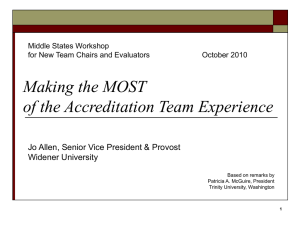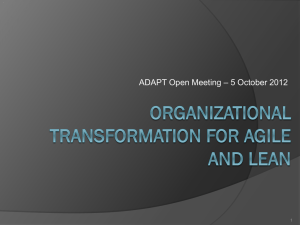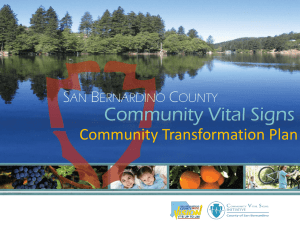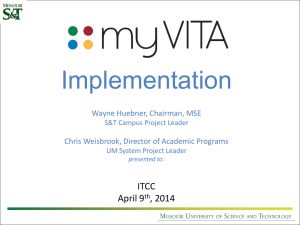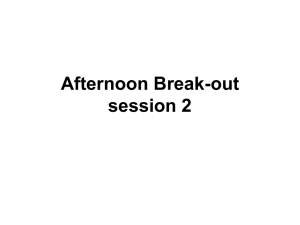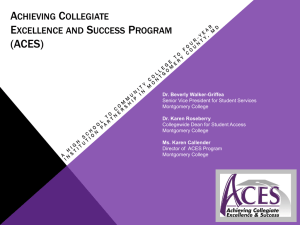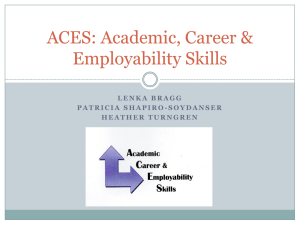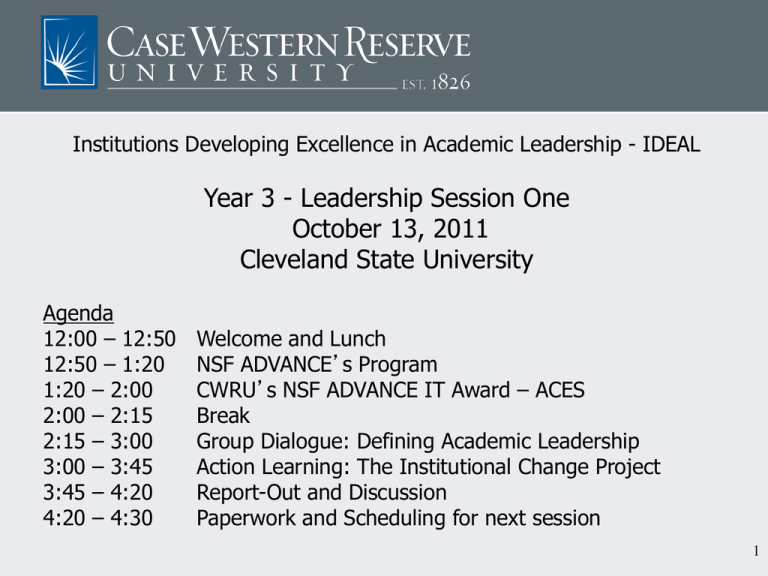
Institutions Developing Excellence in Academic Leadership - IDEAL
Year 3 - Leadership Session One
October 13, 2011
Cleveland State University
Agenda
12:00 – 12:50
12:50 – 1:20
1:20 – 2:00
2:00 – 2:15
2:15 – 3:00
3:00 – 3:45
3:45 – 4:20
4:20 – 4:30
Welcome and Lunch
NSF ADVANCE’s Program
CWRU’s NSF ADVANCE IT Award – ACES
Break
Group Dialogue: Defining Academic Leadership
Action Learning: The Institutional Change Project
Report-Out and Discussion
Paperwork and Scheduling for next session
1
NSF ADVANCE PAID
Institutions Developing Excellence
in Academic Leadership
IDEAL
www.case.edu/provost/ideal/index.html
2009-2012
2
Purpose of IDEAL
Three year partnership of six research
universities in Northern Ohio to stimulate gender
equity related transformation in each institution
by adapting and disseminating successful
mechanisms from CWRU’s ADVANCE IT
program, Academic Careers in Engineering and
Science (ACES) (http://www.case.edu/admin/aces)
3
Components of IDEAL
1. Annual leadership training program for faculty
Change Leader Teams from each university
2. Design, implementation and evaluation of
annual institutional transformation projects
focused around a change theme at each
university
3. Two plenary gatherings of senior university
leaders and program participants from each
campus to focus on topics of gender equity and
inclusion among S&E faculty and review
institutional plans and progress
4
IDEAL Structure
PI: Lynn Singer
Co-PIs: Diana Bilimoria and Helen Qammar
Project Director: Amanda Shaffer
External Evaluator: Mary Wright, Center for Research on Learning and
Teaching, University of Michigan
Advisory Board:
PI, Co-PIs, and IDEAL Co-Directors
W. A. "Bud" Baeslack III, Provost, CWRU
Byron Clayton, Vice-President, NorTech
Melissa Cardenas, Director, Academic Quality Assurance, Ohio Board
of Regents
Abigail Stewart, Prof. of Psychology, University of Michigan
5
IDEAL Co-Directors
Each partner institution is led by an IDEAL Co-Director
Julie Barnes, Associate Dean, College of Arts and Sciences (BGSU)
Diana Bilimoria, Professor of Organizational Behavior (CWRU)
Paul P. Lin, Associate Dean, College of Engineering (CSU)
Mary Louise Holly, Professor of Teaching, Leadership and
Curriculum Studies (KSU)
Helen Qammar, Director, Institute for Teaching and Learning;
Associate Professor of Chemical and Biomolecular Engineering (UA)
Penny Poplin Gosetti, Vice Provost for Assessment and Strategic
Planning (UT)
6
IDEAL – Team Coaches
Each institution is assigned an Team Coach to
facilitate the planning of the institutional change
The Team Coach visits the university campus
twice a year (Oct/Nov and April/May) for groupcoaching sessions and advising on the change
project’s plans and evaluation.
Coaches have worked in CWRU’s ACES project
Coaches listed on contact sheet
7
IDEAL Objectives
Objective 1:
Create a regional learning community of academic leaders in
northern Ohio informed about factors responsible for the
underrepresentation of women and minority groups in
academic S&E and committed to transforming institutional
cultures in S&E disciplines.
Strategy:
CWRU will adapt its successful executive coaching program
to create a regional learning community among six partner
universities through leadership development sessions and
team coaching.
8
IDEAL Objectives
Objective 2:
Develop a cohort of formal and informal S&E leaders at each
partner institution to implement, adapt and sustain
customized change initiatives on individual campuses.
Strategy:
Change Leader Teams will identify and implement annual
change projects, and present their results at a plenary
conference. Each change project will directly impact the S&E
departments included in IDEAL as well as cumulatively
contribute to significant institutional transformation around
an issue identified as important for S&E transformation at
that university
9
IDEAL Objectives
Objective 3:
Assemble the senior academic leadership of partner
universities to disseminate best practices from ADVANCE
institutions, exchange regional institutional research, policies
and practices, and evaluate change initiatives.
Strategy:
To reinforce institutional commitment to gender equity
change initiatives, IDEAL will hold two plenary conferences
in September 2010 and September 2011 attended by senior
university administrators and the Change Leader Teams, to
engage with national experts and discuss each institution’s
transformation efforts.
10
IDEAL Outcomes–Intellectual Merit
Create an intercollegiate regional community of leaders to
share information and ideas on achieving improved
gender participation and equity in academic S&E.
Produce customized institutional transformational
strategies based on identified needs
Facilitate dissemination of ideas and best practices
among partner institutions
Increase regional awareness about assumptions and
practices regarding women’s professional roles and
contributions in S & E disciplines
11
IDEAL Outcomes – Broader Impact
Engender systemic institutional transformation to achieve
equity for women and underrepresented minorities in S&E
disciplines on individual campuses
Stimulate change across postsecondary education in Ohio.
Focus attention on further diversifying S & E presence in
northern Ohio
Inform broader efforts to foster science and technology
careers, and build capacity for a high-tech regional
workforce.
12
Gender Participation in
Science and Engineering
13
What is the Problem?
Myth
“…there are insufficient numbers of women
and minorities on the pathway from
graduate student to faculty member…the
“pipeline” problem.”
Fact:
The data indicate that this is true for
minorities, [in S & E] false for women.
Source: Cathy A. Trower and Richard P. Chait, Faculty Diversity: Too little for too long
14
14
MYTH:
Women Don’t Go Into Science
In 2005, women received over 40% of all BA/BS
degrees awarded by U.S. 4-year colleges and
universities in the following fields:
Astronomy (43% women)
Biology (62% women)
Chemistry (52% women)
Earth Sciences (43%)
Mathematics (45% women)
Ocean Science (50% women)
Psychology (78% women)
SOURCE: NSF SRS S&E Degrees 1966-2006
15
Doctoral Degrees Awarded to U.S. Citizens and
Permanent Residents, by Sex: 1989–2007
SOURCE: National Science Foundation
16
Women with Doctoral Degrees in S&E
In 2006, women received over one-third of all
doctoral degrees awarded to U.S. citizens and
permanent residents in the following fields:
Chemistry (35%)
Earth/Atmospheric and Ocean Sciences (38%)
General Biology/Botany (47%)
Biomedical Sciences (49%)
Cell & Developmental Biology (50.6%)
SOURCE: NSF SRS S&E Degrees 1966-2006
17
Female Share of S&E Postdoctoral
Fellows, by Field: 1996 and 2006
18
MYTH: Once the Pipeline Fills We Will
Have Gender Equity
In biomedical fields the proportion of
women with doctorates has exceeded
40% for two decades.
But, in basic science departments of US
medical schools, the proportion of women
associate professors is below 30%, and
the proportion of women at full professor
rank is 20%.
Source: AAMC Report on U.S. Medical Faculty 2008
19
Women S&E Doctorate Holders Employed
in 4-year institutions: 2006
SOURCES: National Science Foundation, Division of Science Resources Statistics, Survey of Doctorate
Recipients: 2006
20
Women as a Percentage of S&E Doctoral Degrees,
Full-time Full Professors, and Full-time Tenure-track
Faculty at 2- or 4-year Institutions: 2006
SOURCES: National Science Foundation, Division of Science Resources Statistics, Survey of Doctorate
Recipients: 2006
21
A Depiction of the Problem
Pecentage of Employed Doctoral Scientists and Engineers in 4-Year Educational Institutions,
by Sex and Faculty Rank: 2006
(90.0)
(80.0)
(70.0)
(60.0)
Male
Female
(50.0)
(40.0)
(30.0)
(20.0)
(10.0)
S
Instructor/Lecturer
Assistant Professor Associate Professor
Professor
Source: NCSES: Characteristics of Doctoral Scientists and Engineers in the United States: 2006
http://www.nsf.gov/statistics/nsf09317/
22
The Experience of Women Faculty in
S&E
Experience isolation and marginalization
Have few role models and mentors
Have lower access to academic and resource
networks than male colleagues
Have to work harder than their male colleagues
to gain credibility and respect
Report lower satisfaction with their academic
jobs than do male faculty
Report less satisfaction with their department’s
leadership
Sources: Liang & Bilimoria, 2007; Rosser, 2004; Bilimoria et al., 2006; Callister, 2006
23
Problem Summary:
Two Sets of Related Issues
Representation Issues
Lack of a critical mass of women and URM faculty in
S&E at many institutions
Low representation at higher levels in the academic
hierarchy (full professor, endowed chairs) and in
administrative leadership positions
Inclusion Issues
Systemic inequities and barriers to a level playing
field; everyone does not compete equitably
Accumulative advantage: treatments that advantage
some careers over time
Exclusionary climates fail to leverage and value the
skills and experience of all faculty to achieve
institutional goals and objectives
24
Why Address the Development of Women
& URM Faculty?
Underutilizing a resource
Workforce composition of the future
Diverse teams outperform homogenous ones in
complex problem-solving tasks
Diversity in styles and skills brings value to
customers
Fortune 500 companies with the most women
executives deliver more earnings than firms with
the fewest
25
Breaking Barriers and Creating
Inclusiveness: Institutional
Remedies
NSF ADVANCE
ADVANCE portal
www.portal.advance.vt.edu/
Goals of NSF ADVANCE Program
Broaden participation in the US STEM workforce
Recognize that simplistic or piecemeal solutions cannot
eradicate systematic, historical, and widespread gender
inequities
Develop systemic approaches to increase the participation
and advancement of women in STEM careers in academic
institutions
Academic institutions need to implement wider and
deeper change, systematically transforming structures,
processes, work practices, and mental models that
perpetuate inequity
In the process of such transformation, the workplace
becomes supportive and motivating for all its
employees, not just women and other minority groups
27
Evolution of NSF ADVANCE Awards
Leadership
Institutional Transformation (IT)
Partnerships for Adaptation, Implementation and
Dissemination (PAID)
Adaptation and implementation of materials, tools,
research, and practices that have been demonstrated
to be effective
An effort to teach and/or train individuals and groups
how to adopt or adapt the information, materials,
tools, research and practices
IT Catalyst
28
ADVANCE Institutional Transformation
Grantees 2001-2008
Small IT awards to promote promising practices:
• Duke University
• New Jersey Institute of Technology
• Marshall University • University of Maryland, Eastern Shore
29
ADVANCE IT-Start Grantees 2008
(now IT-Catalyst)
30
PAID Grantees 2006-2009
Round 1: 2006
Round 2: 2008
Round 3: 2009
31
ADVANCE Program Evolution
Components Timeline
IT-Catalyst
(07-582, 09-504)
PAID
(05-584; 07-582, 09-504)
Fellows
(01-69; 02-121)
Leadership
(01-69; 02-121; 05-584)
Institutional Transformation
(01-69; 02-121; 05-584; 07-582, 09-504)
32
ADVANCE Program Evolution
Awards Made
ADVANCE Awards 2001-2009
IT
Fellows
IT-Catalyst
45
Total Number of Awards
40
35
Leadership
PAID
22
19
30
11
15
25
20
15
12
10
9
10
14
9
10
5
9
9
13
0
2001 & 2002
2003 & 2004
2005 & 2006
Fiscal Years
2007 & 2008
2009
(2010 pending)
33
Characteristics of Environments That
Enable Gender Equity and Inclusion
Work structures and cultural norms that support
positive relations between men and women
Freedom from stereotyping about women’s and men’s
roles and occupations
Work conditions (e.g., job titles, work schedules,
policies, and physical environment) that include and
value both men and women
A critical mass of women
Opportunities for reward and advancement based on
qualifications, performance and talent, not gender
Work policies and structures that support work-life
integration
Modified from McLean, D. (2003). Workplaces that work: Creating a workplace culture that attracts, retains
and promotes women. Report for the Centre of Excellence for Women’s Advancement. Ontario: The
Conference Board of Canadawww.womensdirectorate.gov.yk.ca/pdf/workplaces_that_work.pdf
34
Elements of a Vibrant and Engaging
Environment for All
Compliance
Diversity
Equity
Inclusion
35
Increasing the Flow
into the Pipeline
For non-tenure track
faculty
- Research funds
- Mentoring, coaching
- Career development
For undergraduates,
graduates & post-docs
- Special programs for
academic career tracks
- Scholarships
- Summer research
experiences
- Mentoring
- Mentoring training for
faculty advisors
- Information &
networking sessions
For high school students
- Specially developed
science & math courses
- Introductory program
into engineering
Improving Institutional Structures & Processes Related to Transition Points
Recruitment
Special committees to study and help with
recruitment
Assistance to search committees in
identifying and meeting with candidates
Training to search committees on potential
biases and best practices
Funding for targeted recruitment
Dual career hiring policies & practices
Tools & resources for search committees
Receiving
PhD
Tenure and/or
promotion to
associate professor
rank
Entering a tenure-track
position as assistant
professor
Women in
non-tenure
track
positions’
experience
Pipeline
Initiatives
Promotion, Tenure, Retention &
Advancement to Leadership
Special committees to study
processes of P&T
Tools & training for decision makers
on evaluation biases & best practices
Information sessions for faculty to
increase transparency in decision
making
Special consultants and mentors for
women reaching promotion/tenure
Tenure extension policies
Pre-tenure
women’s
experience
Equipping Women to Successfully Progress in the Pipeline
Pre-tenure Women
Career development programs
Professional/academic training and
development related to teaching,
research, lab & student supervision,
work-life integration, leadership
Informational lecture series
Mentoring, coaching
Providing role models
Networking
Funding for research & career
advancement
Showcasing women scholars
Promotion to
professor rank
Tenured
women’s
experience
Tenured Women
Leadership development
programs
Professional/academic
training and development
Mentoring
Funded professorships
Funding for research and
career development
Special funding and
programs for re-starting
research after a hiatus
Showcasing women leaders
Advancement to
leadership
Tenured
women’s
experience
Academic Pipeline for Women
Climate
Initiatives
Improving the Awareness and
Practices of Male Colleagues
Professional development & training
Informational lecture series
Mentorship education
Leadership development coaching
Faculty awards
Grassroots committees and taskforces
Academic Climate
Improving Departmental (Micro) Climate
Department transformation programs
Funding for departmental transformation projects
Assistance to department strategic planning
Department-specific seminars/workshops
Training and presentations to department chairs
Coaching department chairs & senior faculty
Cross-departmental committees
Increasing Organizational Awareness
Advisory councils on women & minorities
Information sessions & presentations
Conferences, leadership retreats
Distinguished lectureships by senior
women
Gender awareness training for students
Interactive theater presentations
Publicizing family-friendly policies
36
Illustrative Examples of New Structures, Policies, and
Procedures (see ADVANCE portal website)
NSF ADVANCE Institution
New Structures, Policies, and Procedures
Case Western Reserve University
www.case.edu/admin/aces/
3 new endowed chairs for women faculty in S&E; Associate Dean of Faculty Development in Case School of
Engineering and School of Law; diversity specialist position in the Provost’s Office; a research analyst position in
the Institutional Research office; a graduate student position in the FSM Center for Women; creation or revision of
university faculty policies including automatic pre-tenure extension and work release policies
New Mexico State University
www.nmsu.edu/%7Eadvprog/faculty.ht
m
Dual career couples: New Mexico State University and the University of Texas at EI Paso support efforts to
accommodate the needs of dual career couples. Job sharing arrangement may be established when two people are
in the same academic department.
University of Alabama at Birmingham
http://main.uab.edu/sites/ADVANCE/8
7552/
Family-friendly leave policies: family and medical leaves of absence; personal leave of absence, sick leave and
emergency absences
University of California, Irvine
http://advance.uci.edu/
Family Policies: Career partner program; The UC faculty family friendly edge; UC family friendly policies for
faculty and other academic appointees.
University of Rhode Island
http://ww2.wdg.uri.edu:81/testsite/inde
x.php?adv_work
Dual career partners: Proposed dual career guidelines; Parental leave policy; Tenure clock extensions; Child care
University of Washington
www.engr.washington.edu/advance/pol
icies/index.html
Policy transformation: Recommendations to Chairs for Facilitating Dual Career Hires; Family leave and tenure
clock extension; Dual Career Hires; Part-Time Faculty policies
Utah State University
http://websites.usu.edu/advance/Docum
ent/index.asp?Parent=6257
Dual Career Committee; Dual Career Accommodation Protocol: Inform candidates about dual career
opportunities; Request dual career accommodation; Identify possibilities for accommodation; Contact target units;
Evaluate and interview the potential candidate; Negotiate a financial package; Write a request letter to the
executive vice president and provost; Receive confirmation letter from executive vice president and provost; Make
an employment offer.
Virginia Polytechnic Institute and State
University
www.worklife.vt.edu/
Child care; Stop-the-clock policy: Meetings with department heads aim to develop better understanding of the
policy and to encourage more consistent implementation.
37
NSF ADVANCE- Institutional Transformation
for Gender Equity and Inclusion
Research & Evaluation in Support of Transformation
- Tracking Key Indicators of Representation, Equity, and Inclusion
- Benchmarking and Climate Studies
- Evaluation of Interventions
- Improving Internal Collection, Analysis, and Use of Data
Factors Facilitating
Transformation
Internal
- Senior administrative
support and involvement
- Widespread collaborative
leadership and synergistic
partnerships
- Clear vision, flexible
path, and milestones
- Visibility of actions and
outcomes
External
- NSF funding
- Cohort of NSF ADVANCE
peer institutions
Transformational Initiatives To
Remove Inequities and Create
Inclusiveness
Pipeline Initiatives:
- Increasing the flow into the pipeline
- Improving organizational structures and
processes related to key career transition
points
Recruitment
Promotion
Advancement to leadership
- Equipping women and minorities to
successfully progress in the pipeline
Career stage-specific inputs
Organizational Climate Initiatives:
- Improving the awareness and practices of
male colleagues and decision makers
- Improving departmental (micro) climates
- Increasing organization-level
attention to diversity, equity, and
inclusion issues
Institutional
Transformation
Outcomes
- Increased representation of
women and minorities at all
ranks and in leadership
- Equitable, inclusive and
energizing workplace for all
Institutionalizing the
Transformation
- Creating new structures,
positions and groups
- Implementing new and
modified policies
- Incorporating successful
change initiatives
- Creating tool kits and
guidelines, and providing
resources for improved
practices
Source: Bilimoria et al (2008). Breaking Barriers and Creating Inclusiveness: Lessons of Organizational Transformation to Advance 38
Women Faculty in Academic Science and Engineering, Human Resources Management, 47, 3: 423-441
Initiatives of 19 NSF ADVANCE
Institutions
Source: Fox, M. F. (2008) Institutional Transformation and the Advancement of Women: The Case of Academic Science and
Engineering, in Smart, J. C. (ed.), Higher Education: Handbook of Theory and Research, 23: 73-103.
39
NSF ADVANCE Institutional
Transformation at CWRU
Academic Careers in Science and
Engineering(ACES) 2003-08
ACES+ (2008 onwards)
40
Academic Careers in Engineering
and Science (ACES)
Program launched initiatives in 32 STEM
departments in four schools, plus universitywide activities
NSF-ADVANCE $3.5 million grant
ACES Mission: To promote a campus-wide
culture characterized by equity, participation,
openness, and
accountability.www.cwru.edu/admin/aces/
41
ACES Major Initiatives 2003-08
Commitment of Senior Administrators
Accountability of Deans
New Structures
& Policies
Departmental Climate
Improvement Initiatives
University
Leadership
Search Committee
Training & Support
Promotion & Tenure
Committee Training
School and Department
Level
Chairs’ Leadership
Development
Annual Monitoring of Gender
Equity Data
Coaching, mentoring,
networking, and training &
development of deans, chairs,
women faculty in S&E depts.
Distinguished
lectureships
Minority student
pipeline
Individual Level
Student Gender
Awareness
Provost’s Annual Leadership Retreat
Opportunity Grants
for Women Faculty
Hotline Coaching
for Women faculty
42
Leadership Development Initiatives
Annual Provost’s Leadership Retreat
Sponsored nine department chairs to attend
leadership development workshops
Executive coaching for deans, associate deans,
chairs and associate chairs
Orientation for Newly Promoted and Tenured
Faculty
Expanded Orientation for New Faculty
Participation in Bryn Mawr Summer
Institute for Women Faculty and Staff
43
School and Department Level
Initiatives
Faculty search committee supports
Networking
Women faculty lunches; department chairs’ lunches with Provost
Awards: Women of Achievement, Spotlight Series Prize,
Recognitions for Tenure and Promotions
Annual theatre party
Educational and skill building workshops for departments
(communications, mentoring)
Undergrad/grad student gender-awareness training
Support for meeting facilitators, strategic planning
Faculty Exchange with HBCU’s
Departmental Initiative Grants
Distinguished Lectureships for
senior women faculty visits
44
Individual Level Initiatives
Opportunity grants
Executive coaching for career and leadership
development of women faculty in S&E
Hotline coaching for women faculty across the university
Mentoring initiatives
Mentoring discussions and/or senior faculty panels in
each school for junior women faculty
Mentoring committees
Peer (or near peer) mentoring groups
Speed Mentoring at Research ShowCase
Summer Undergraduate Research Program
(SURP) for minority women students
45
Faculty Development Workshops
Gendered Communication in Academe
Negotiation at the Academy
Successful Mentoring
Effective Communication Skills: What They Didn’t Teach
You in Chair School
Success Strategies for Women in Academic Careers
Communicating with Influence in the Academy
Emotional Intelligence in the Academic Workplace
Developing and Retaining Junior Faculty in Lean Times: A
Senior Faculty Conversation
Strengthening Our Roles As Change Agents in the
University
46
Coordination and Collaboration of
Allies across the Campus
Faculty Diversity Office
The Flora Stone Mather Center for Women
President’s Committee on Minorities
President’s Committee on Women
Faculty Senate Committee on Minority Faculty
Faculty Senate Committee on Women Faculty
Faculty Senate Executive Committee
WISER (Women in Science and Engineering Roundtable)
Women Faculty of the School of Medicine
Student Groups: Spectrum (LGBT), Catalyst (social
justice)
47
Research Undertaken
Faculty Focus Groups & Interviews, 2000 and
2004
ADVANCE Program NSF Indicators, 2003-2008
Science Department Study, 2004-05
COACHE Junior Faculty Surveys, 2006 and 2009
Faculty Climate Surveys, 2004 and 2007
Faculty Exit Surveys, 2005-2008
Second Year Faculty Surveys, 2005-2008
Salary Equity Studies, 2006-present
Candidate Pool Analysis Study, 2007-08
48
ACES Outcomes (2003-08)
and ACES+
Number of Tenure Stream Faculty in S&E
by Gender from AY 2003/04 - 2007/08
50
Number of S&E Department Chairs by
Gender
Number of S&E Department Chairs By Gender
12
10
10
8
8
7
7
6
Chairs
6
5
5
3
4
2
5
2
1
0
0
0
1
2003
2008
2003
1
0
2003
Female
Male
2008
CAS
2003
2008
CSE
WSOM
2008
SOM
51
Number of S&E Faculty Holding
Endowed Chairs by Gender
Number of S&E Faculty Holding Endowed Chairs
from AY2003-04 to AY2007-08
70
59
60
59
54
50
49
50
40
30
20
14
12
10
8
15
9
0
AY2003-04
AY2004-05
AY2005-06
Female
AY2006-07
AY2007-08
Male
52
Selected 2004 and 2007 Climate
Survey Comparisons
*p<.05, **p<.01, ***p<.001.
2004 scale: 1. Not at all, 2. Very Little, 3. Adequate and 4. Very Much.
2007 scale: 1. Not at all, 2. Minimal, 3. Moderate, 4. Extensive.
53
Changes in Climate Experienced by
Women Faculty (2004-2007)
In 2004, women faculty in comparison to men faculty
reported:
lower community and job satisfaction
lower ratings of the leadership effectiveness of their
primary unit head
lower resources and supports for academic performance
from their primary unit head.
These significant differences disappeared in the 2007 survey.
However, similar to 2004, in 2007 women faculty in
comparison with men faculty, continued to report:
lower ratings of value and inclusion in their primary unit
higher ratings that gender and race make a difference in
how faculty are treated in their primary unit
a greater sense of pressure and restrictions.
54
New Positions Created
Vice President of Diversity, Inclusion and Equal
Opportunity
Associate Dean for Faculty Development in the Case
School of Engineering
Assistant Dean of Faculty Development and Diversity in
the School of Medicine (search initiated)
2 new endowed chairs for women faculty in S&E with
partial funding in place for a third chair
Manager of Faculty Diversity and Development in the
Office of Faculty Diversity
Assistant Director in the Flora Stone Mather Center for
Women
Research Analyst in the Office of Institutional Research
55
New or Modified Policies during 200308
Automatically approved pre-tenure extension policy
Partner hiring (dual career) policy
Modified work duties (paid parental leave) for faculty &
staff
Domestic Partner Policy
Consensual relations policy
Non-Discrimination Statement for LGBT, including gender
expression and identity
56
New Permanent Programs and
Activities
Established within the Office of the Provost
CWRU-Fisk University partnership
Summer internship program for minority women S&E students
Annual Provost’s leadership retreat for all university deans and chairs
LGBT Center
Opportunity grants for women S&E faculty
Distinguished Lectureships for campus visits by senior women
Established in the Office of Faculty Diversity
Required cultural competency awareness training for all new faculty
Faculty search committee training and support
Established in the FSM Center for Women
Annual Spotlight Series on Women’s Scholarship
Women of Achievement Lunch
WISER (Women in Science & Engineering Roundtable)
Women Faculty Leadership Institute
Established University-wide
Faculty work-life policies and resources
Ethnic Studies program
Faculty climate survey (3 years); COACHE junior faculty survey (2 years)
57
Faculty Development Activities
Institutionalized
Twice-yearly university-wide faculty development
& networking workshops for women faculty
Professional coaching for new chairs and deans
and new women S&E faculty established in the
Office of the Provost
Annual orientation for newly tenured & newly
promoted faculty
Expansion of the new faculty orientation
Leadership workshops and junior faculty
mentoring through the Case School of
Engineering Office of Faculty Development
58
In Addition, ACES+ Advance
Continues
Opportunity grants for women faculty across the
university
Distinguished Lectureships for campus visits by
senior women scientists
Executive coaching for new chairs and women
faculty in S&E
Hotline coaching for women faculty across the
university
Student Undergraduate Research Program for
Minority Women
59
Agenda
2:00 – 2:15
2:15 – 3:00
3:00 – 3:45
3:45 – 4:20
4:20 – 4:30
Break
Group Dialogue:
The Work of Academic Leadership
Action Learning:
The Institutional Change Project
Report-Out and Discussion
Paperwork and Scheduling
60
Group Dialogue:
The Work of Academic Leadership
Brainstorm Questions:
How do we define academic leadership?
What are examples of academic leadership?
61
Action Learning: Identifying the
Institutional Change Project
•
•
•
•
Advancing the University’s IT theme
Campus needs
Project ideas
Report out: 2 - 3 action steps
62
Action Learning: Identifying the
Institutional Change Project
Report Out and Discussion
63
Paperwork and Scheduling
64
Project Development
Teams should meet prior to the next leadership
session on November 30th (with team coach if
possible) to clarify/finalize project.
A report on the project proposal from each
Change Leader Team is expected at session #2,
November 30th.
Template for proposal will be on the participant
document page on the website with todays
slides.
65
Financial Paperwork
Stipends processed after receipt of all forms
(signed copy of MOU, W9 and ESSPR).
Stipends are distributed at Leadership Session
#2 Wednesday, November 30th, or mailed
immediately after.
Reimbursements for mileage, tolls and parking
must be submitted on forms provided by IDEAL
(travel pdf on participant page) and include
original toll/parking receipts. Keep copies, send
originals.
66
Scheduling - See Timeline
Next Leadership Session - Wednesday, November 30,
2011 12:00 p.m. - 4:30 p.m. at Kent State University
http://www.doodle.com/z8yt8bnr945mmii2
On-Campus Team Coaching
Two sessions to aid the design and implementation of the
institutional change project.
Scheduled with the coach by the Change Leader Team
and Co-Director.
Meeting #1 Oct/Nov 2011. Meeting #2 April/May 2012
67
Important Dates for 2010/2011
Leadership Session #3
Friday, March 2, 2012, Video Conference
Pair by proximity, choose one location
BGSU & UT
CSU & CWRU
KSU & UA
Leadership Session #4
Tuesday, April 10, 2012 Bowling Green State University
Plenary Conference – tentatively proposed
September 28, 2012
9:30 a.m. – 4:00 p.m.
Cleveland Botanical Gardens, Clark Hall
68
Evaluation, etc.
Kindly complete the Yellow Event Evaluation
included in you materials and leave on desk
Return name tag and table tent for reuse
Presentations and other relevant documents will
be posted on the participant readings web page
tomorrow.
If you drove, please tell parking you were
attending the IDEAL Leadership Session
69
See you on November 30th
at Kent State University
70



